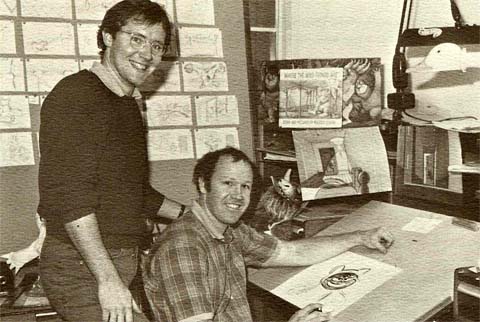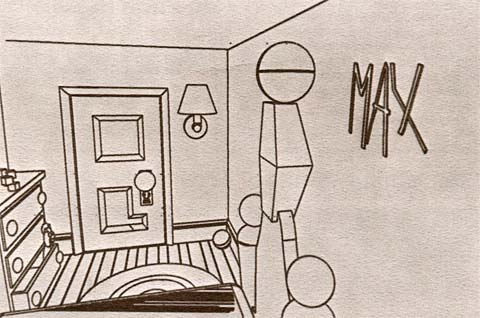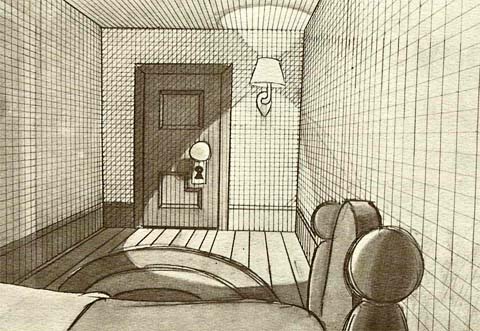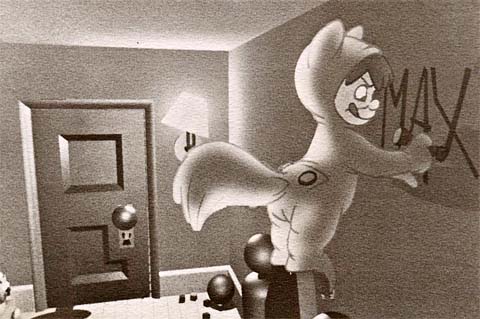

‘Where the Wild Things Are’: An Early CG Experiment by John Lasseter and Glen Keane
Hans Perk recently posted scans from a 1983 edition of the Disney Newsreel, an in-house newsletter about happenings around the studio. The issue had an article about an animation test created by John Lasseter and Glen Keane using Maurice Sendak’s Where the Wild Things Are as subject matter.
While the project will undoubtedly be familiar to fans of Lasseter and Keane, I found the article’s contemporaneous account of the production to be interesting, especially Lasseter’s quote: “In five years these tests will seem so primitive, they’ll look like Steamboat Willie does today.” Below I’ve reformatted the piece for easy on-line perusal:
“Experimenting with Computer Generated Graphics”
Originally published in the Disney Newsreel (vol. 12, no. 23; June 10, 1983)
Disney’s animated cartoons have been extremely popular in the past, focusing strictly on drawn animation in a carefully realistic style. The release of TRON last summer has indicated that Disney artists are beginning to experiment with new animation technologies and techniques.
TRON was the first motion picture to incorporate an extensive use of computer-generated graphics. At the time of the production of the film, the state-of-the-art images that the computer produced were too metallic and precise. Because of those characteristics, the computer’s application was ideally suited for the “environment” of TRON , but totally inappropriate for the organic and “dreary” look of Something Wicked This Way Comes.

One of the challenges presented to Disney animators today is to create computer-generated images with a human or animated element. It is the challenge Glen Keane and John Lasseter are accepting.
Based on Maurice Sendak’s award-winning children’s book, Where the Wild Things Are, Glen and John are combining drawn animation and computer images in a series of film tests.

The Wild Things test is done by encoding characters’ and background perspectives and the changing position of the camera into the computer. MAGI Synthavision Inc. (Mathematical Applications Group Inc.) artists and technicians create simple groups of geometric shapes that represent the basic forms of the characters and put them in a computer-generated model of the set. This is all done according to the position of the camera as it follows the action in the film, and these resulting images are photographed. Drawings are electronically encoded back into the computer which places them in the correct positions within the set in each frame. The computer will also color the animated drawings, adding shadows and highlights according to the animator’s instructions. This entire images is photographed on film by the computer for the final product.

The entire process gives the perspective of a three-dimensional cartoon, with the camera moving in and around obstacles in the environment.
The Wild Things test is being done to determine the success of both animator and computer interacting with one another. Disney animators want to see if this technology can be incorporated to enhance or even re-design the traditional “animated cartoon.”
According to the head of Disney’s Special Visual Effects, Lee Dyer, “[Motion Picture Production Vice President] Tom Wilhite is encouraging us to try different things.”
John, Joe Ranft and Brian McEntee are developing The Brave Little Toaster, which in its final form could become a 70-minute full-length feature film. “Basically, Wild Things is a test piece,” explains John, “but we would like to use this technique for The Brave Little Toaster.”
Part of the problem with expediting the film’s production is the limited ability Disney has to create computer-generated images. All work in the past has been done by outside computer imagery firms.
The combination of computer-generated graphics and Disney animation is in its very basic stages in terms of what is could eventually become. John reports that, “In five years these tests will seem so primitive, they’ll look like Steamboat Willie does today.” But just as Steamboat Willie gave Disney the recognition as a forerunner in animation technology some 50 years ago, The Wild Things test and The Brave Little Toaster have the potential to giver Disney similar recognition in the future.
And the finished test in case you’ve never seen it:

.png)